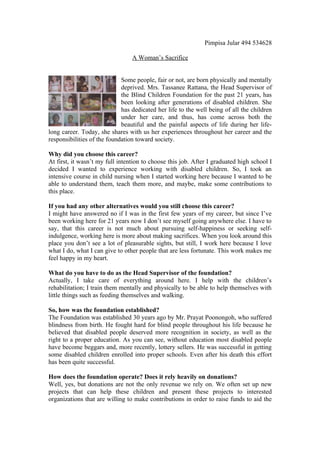
News Reporting
- 1. Pimpisa Jular 494 534628 A Woman’s Sacrifice Some people, fair or not, are born physically and mentally deprived. Mrs. Tassanee Rattana, the Head Supervisor of the Blind Children Foundation for the past 21 years, has been looking after generations of disabled children. She has dedicated her life to the well being of all the children under her care, and thus, has come across both the beautiful and the painful aspects of life during her life- long career. Today, she shares with us her experiences throughout her career and the responsibilities of the foundation toward society. Why did you choose this career? At first, it wasn’t my full intention to choose this job. After I graduated high school I decided I wanted to experience working with disabled children. So, I took an intensive course in child nursing when I started working here because I wanted to be able to understand them, teach them more, and maybe, make some contributions to this place. If you had any other alternatives would you still choose this career? I might have answered no if I was in the first few years of my career, but since I’ve been working here for 21 years now I don’t see myself going anywhere else. I have to say, that this career is not much about pursuing self-happiness or seeking self- indulgence, working here is more about making sacrifices. When you look around this place you don’t see a lot of pleasurable sights, but still, I work here because I love what I do, what I can give to other people that are less fortunate. This work makes me feel happy in my heart. What do you have to do as the Head Supervisor of the foundation? Actually, I take care of everything around here. I help with the children’s rehabilitation; I train them mentally and physically to be able to help themselves with little things such as feeding themselves and walking. So, how was the foundation established? The Foundation was established 30 years ago by Mr. Prayat Poonongoh, who suffered blindness from birth. He fought hard for blind people throughout his life because he believed that disabled people deserved more recognition in society, as well as the right to a proper education. As you can see, without education most disabled people have become beggars and, more recently, lottery sellers. He was successful in getting some disabled children enrolled into proper schools. Even after his death this effort has been quite successful. How does the foundation operate? Does it rely heavily on donations? Well, yes, but donations are not the only revenue we rely on. We often set up new projects that can help these children and present these projects to interested organizations that are willing to make contributions in order to raise funds to aid the
- 2. Foundation’s work. Donations are received from various sectors but on an infrequent basis. Does the donated money go directly to children’s healthcare for both the mentally and physically impaired? Our children’s health is extremely important, because fundamentally these children are blind and with this comes other complications. Sporadically, seizures and contractions become present, which means specialized medical teams and medicines are required. When it comes to emergency cases, private hospitals are involved, thus, resulting in large spending. Sometimes there is just not enough funds for everything. Our revenue can become an obstacle in accessing the best resources available for these children but we try to make the best use out of what we have. When you say that the children have other disabilities apart from being blind, what are they? Mostly, the children suffer from blindness, mental disability, and physical deprivation. With most mentally disabled children, the ability to communicate is very difficult. Without awareness, they habitually hurt themselves by slapping themselves or hitting their head on any hard object they can find. All of them do not know how to take care of themselves; so, we take care of them three times a day and help them with their normal routines such as feeding, showering, and their body excretions. How do you think the foundation contributes to the society? I really think that the foundation helps our society a lot, especially with the issue of disabled children. We want to contribute more, but unfortunately lack the capital and personnel. I think if these issues are addressed appropriately, more disabled children would be receiving the help they so desperately need. What are your best and worse experiences in this career? I think the best part is that it makes me feel good about myself. I can actually value myself and what I do in a positive way. Obviously, it is because these children are so pure-hearted, there is no pretence from them. Everybody that works here sees this place more like a home and not a place for less fortunate children. The worst part is that sometimes the miseries of seeing these children suffer, and being rejected by their families affects my morale. I used to think of quitting, but who would look after them the way I do. The children are my encouragement. Lastly, I understand that the Blind Children Foundation is separated from other secular sectors; however, what is your personal opinion toward Thailand’s political situation at the moment? I would say that I am quite neutral. I am not taking any sides. I just hope that whichever party is in government will lead our country in a better direction, and try to do something about the smallest group of people within our society that need help.
